Dec 29, 2025
Dec 29, 2025
Babur, Humayun and Sher Shah
The Delhi Sultanate – An Uncertain Legacy
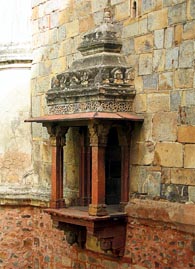 A political vacuum – this phrase can best summarize the state of affairs in north India in 1526 AD. The last of the Lodi sultans had succeeded in alienating the majority of his nobles by his arrogant posturing. Ibrahim Lodi’s pretensions were to prove his downfall in a land where class and clan loyalties were precarious at best.
A political vacuum – this phrase can best summarize the state of affairs in north India in 1526 AD. The last of the Lodi sultans had succeeded in alienating the majority of his nobles by his arrogant posturing. Ibrahim Lodi’s pretensions were to prove his downfall in a land where class and clan loyalties were precarious at best.
And yet the Delhi sultanate had, in the last three centuries, left an undeniable mark on the subcontinent. Firstly it introduced Islam along with its culture - literature, painting, philosophy. Secondly the sultans put into place a system of administration - revenue collection, taxes and minting - that would serve as the base for their successors the Mughals. And lastly, and important as far as we are concerned, they established firmly the principles of Islamic architecture - which from its Persian and Turkish origins was to evolve into many regional prototypes.
The Lodi dynasty was thus fated to be the last in the Delhi Sultanate. After the extinction of the Tughlaq dynasty at the hands of Tamerlane, the Lodis finally assumed power at Delhi. In spite of the empire building efforts of the first two of the line, Bahlol and Sikander, Ibrahim Lodi frittered away their gains by his imperious manner. This he did largely forgetting that the Sultan’s power base was eventually his nobles, that he was at best first among equals.
The Afghan nobles thus found themselves allied, along with certain Rajput chieftains - chief among whom was Rana Sanga of Chittor - with the disinherited Timurid prince Babur, from Ferghana. In search of a new land to claim for his own, Babur was a young, ambitious and ruthless warrior who knew an opportunity when he saw one.
And so came about the first battle of Panipat. This was to be the ground for many a decisive battle afterwards, its fertile plains proving ideal ground for the massing of armies. The Sultan’s 100,000 horsemen and 1000 elephants far outnumbered Babur’s troops, but it was his use of artillery, for the first time in India, that won him the day.
The Delhi Sultanate, at the seat of power at Delhi since the 12th century, thus finally came to an end. Never controlling more than a part of north India, it left behind a fractured and divided subcontinent characterized by the lack of central power, and numerous princes and would-be sultans. Winning and keeping control of an empire here would require finesse and tact, brutality and astuteness.
The Beginning of the Mughal Empire
In dividing history into periods, this stage is chiefly taken as the end of the Delhi Sultanate, and the beginning of the Mughal period. However, Mughal supremacy in India was not established till the reign of Akbar and before that there were times when the Mughals were in danger of extinction. This danger came from the brief reign of the Afghan Sher Shah Sur, of Sasaram in Bihar. For a while he succeeded in chasing Humayun from the subcontinent, and were it not for his accidental death, the Mughal destiny in India might have ended before it begun. This period in history thus show a flux in political power at Delhi, with the short reign of Babur giving way to Humanyun. He in his turn was defeated by Sher Shah, only to return after the latter’s death. Thus with war taking precedence, architectural activity was sporadic at best. Yet a number of notable changes came about, mainly with the Timurid and Safavid influences which came along with Babur.
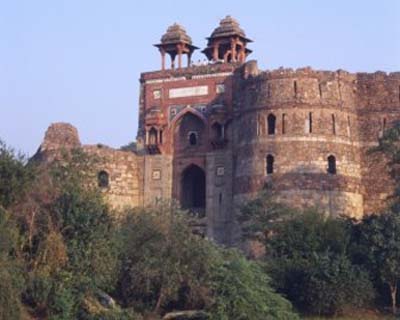 The founder of the Mughal empire did not have much time for architectural construction. The Ram and Zahara Bagh at Agra is a garden that ameliorated the climate that Babur so detested, and also a talar before the Lodi palace.
The founder of the Mughal empire did not have much time for architectural construction. The Ram and Zahara Bagh at Agra is a garden that ameliorated the climate that Babur so detested, and also a talar before the Lodi palace.
The Purana Qila
The main citadel of the time, which can be attributed to both Humayun and Sher Shah, is the Purana Qila at Delhi, with its associated structures.
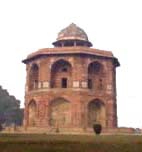 Though the walls are crumbling in places, the massive portals of the Qila are still for the most part intact and show a fine sense of proportion combined with a judicious mix of local red sandstone, Persian-inspired encaustic tile work and marble mosaic.
Though the walls are crumbling in places, the massive portals of the Qila are still for the most part intact and show a fine sense of proportion combined with a judicious mix of local red sandstone, Persian-inspired encaustic tile work and marble mosaic.
Of the structures inside the Qila, two of the most notable are the Sher Mandal, the octagonal library. The library was to prove ill-fated as it is from its steps that Humayun tumbled to his death.
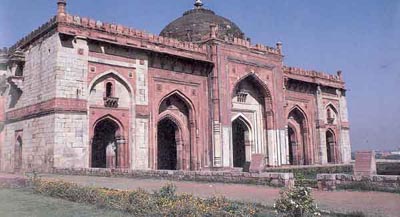 The other is the superb Qila-i-Kuhna mosque. This should also be compared with the Jamali Masjid of roughly the same period near the Qutb Minar complex. Both these mosques are of similar pedigree, with five frontal arches of which the central one is made the most prominent. However, in the Qila-i-Kuhna, the subtle variations of the arch heights are among the features that mark this as the high point of mosques of this plan type.
The other is the superb Qila-i-Kuhna mosque. This should also be compared with the Jamali Masjid of roughly the same period near the Qutb Minar complex. Both these mosques are of similar pedigree, with five frontal arches of which the central one is made the most prominent. However, in the Qila-i-Kuhna, the subtle variations of the arch heights are among the features that mark this as the high point of mosques of this plan type.
Sher Shah’s Tomb
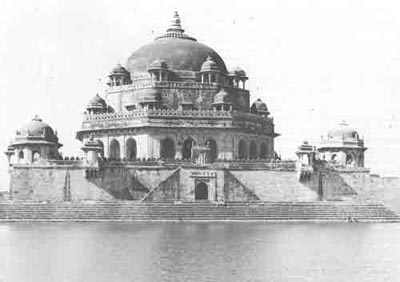 A word should also be added here for the fine tomb of Sher Shah Sur at Sasaram in Bihar. This tomb was the apogee of the octagonal type which found its beginnings in the Tughlaq and Lodi dynasties. Situated in the middle of a lake, the tomb obeys all the principles of octagonal tombs – arched side openings, buttressed walls and chhattris, but takes them to a previously unsurpassed level of grandeur not only in size, but also cohesiveness of concept. The magnificent setting of the tomb is eloquent, and speaks of the quirks of fate. But for a cannon exploding ahead of time which caused Sher Shah’s death, the Mughal empire that came after him may never have been able to take root.
A word should also be added here for the fine tomb of Sher Shah Sur at Sasaram in Bihar. This tomb was the apogee of the octagonal type which found its beginnings in the Tughlaq and Lodi dynasties. Situated in the middle of a lake, the tomb obeys all the principles of octagonal tombs – arched side openings, buttressed walls and chhattris, but takes them to a previously unsurpassed level of grandeur not only in size, but also cohesiveness of concept. The magnificent setting of the tomb is eloquent, and speaks of the quirks of fate. But for a cannon exploding ahead of time which caused Sher Shah’s death, the Mughal empire that came after him may never have been able to take root.
23-Mar-2003
More by : Ashish Nangia

|
Sir, can you tell me how can i read complete history of Sher Shah suri |